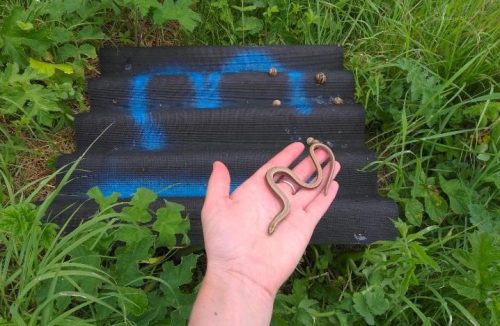Snakes, lizards and slowworms are secretive and cryptic, so spotting them requires a bit of skill and knowledge, and sometimes assistance from artificial refuges. The chances of detecting them are dependent on weather and time of day, as well as season.
The Amphibian and Reptile Conservation Trust has a national recording scheme that you can register for. If you don’t think you have the time or manpower to manage the four visits required, and/or you want to set up a landscape-scale survey instead of one or two sites, you could use the methodology below. If you can’t manage three visits, spring and autumn would be the minimum.
- To survey a 1×1-km square of land, you’ll need an Ordnance Survey grid map, farm field map, binoculars and least 25 heat-attracting mats – 50cm x 50cm, made of onduline, roof felt or corrugated tin.
- To survey a landscape scale area, it’s best to design permanent survey routes, along which you can lay your artificial refugia. Using the Ordnance Survey 1km grid, select alternate squares, and get enough reptile mats for the number of squares you are surveying.
- In each square, identify a survey route that includes potential reptile habitat such as rough grassland, heathland, hedge bases, sunny banks/slopes, woodland edges and glades, brash piles, manure/compost/rubble/rubbish heaps, rock/scree.
- Lay out the mats in mid-April along your survey route. You may want to number them to help keep track of mats on long linear features. Press them to the ground in suitable habitat, and remember to mark exact location on your map– they can vanish as vegetation grows! You could tie hi-vis tape on a branch nearby.
- Walk your route at least three times – once in spring, summer and autumn.
- Choose sunny or partial cloud conditions when air temperature is 10-20°C. First sunshine after rain or a prolonged dull spell can be a good time to survey. Early morning and late afternoon are best.
- Scan ahead with binoculars on likely basking areas (adders are often spotted this way).
- Check refugia by approaching quietly (lizards usually bask on top). Hold the mat at the back, and lift towards you. Identify any reptile to species and record the mat number or location.
- The Amphibian and Reptile Conservation Trust has a good identification guide.
A juvenile slowworm found using an onduline reptile mat © Jess Brooks

